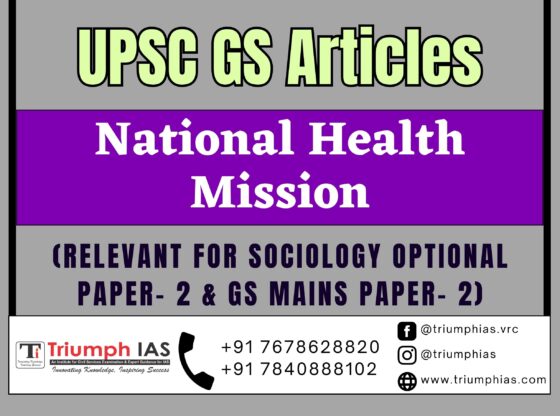National Health Mission
Relevant for sociology optional Paper- 2 & GS Mains Paper- 2

National Health Mission (NHM) is a flagship program launched by the Indian Government in 2013 with the aim of providing comprehensive healthcare to all citizens, especially those in rural and remote areas. The program was initially launched as the National Rural Health Mission (NRHM) in 2005, and later expanded to include both rural and urban areas.
The NHM seeks to address the gaps in the existing healthcare system, including inadequate infrastructure, insufficient human resources, and lack of access to quality healthcare services. The program focuses on strengthening the primary healthcare system, improving maternal and child health, and tackling communicable and non-communicable diseases.
One of the key components of the NHM is the establishment of Health and Wellness Centers (HWCs) across the country. These centers are intended to be the first point of contact for primary healthcare services, providing a range of services including preventive care, diagnostics, and treatment for minor ailments. The HWCs also serve as a referral link to higher levels of healthcare facilities for more complex cases.
Under the NHM, the government has also prioritized the provision of maternal and child healthcare services. The program has set ambitious targets for reducing maternal and child mortality rates, increasing the institutional delivery rate, and improving the coverage of immunization programs. To achieve these targets, the NHM has introduced several initiatives such as the Janani Suraksha Yojana, which provides cash incentives to pregnant women for institutional deliveries, and the Mission Indradhanush, which aims to increase the coverage of immunization services.
In addition to addressing the gaps in the healthcare system, the NHM also focuses on the prevention and control of communicable and non-communicable diseases. The program has launched several initiatives to combat diseases such as tuberculosis, malaria, and HIV/AIDS, as well as promoting healthy lifestyle habits to prevent non-communicable diseases such as diabetes and hypertension.
The NHM also recognizes the importance of human resources in the healthcare system and has launched several initiatives to address the shortage of healthcare professionals in the country. These initiatives include the creation of new medical colleges and nursing schools, the provision of incentives for doctors and nurses to work in rural areas, and the training of community health workers to provide basic healthcare services.
Another important component of the NHM is the use of technology to improve healthcare services. The program has launched several e-health initiatives, including the National Health Stack and the National Digital Health Mission, to create a digital infrastructure for the healthcare system. These initiatives aim to improve the efficiency and effectiveness of healthcare service delivery, as well as provide citizens with greater access to their health records and healthcare services.
The NHM has also been instrumental in promoting the concept of universal health coverage (UHC) in India. The program aims to provide financial protection and access to quality healthcare services to all citizens, regardless of their socioeconomic status. To achieve this goal, the NHM has launched several health insurance schemes such as the Ayushman Bharat Pradhan Mantri Jan Arogya Yojana, which provides cashless healthcare services to vulnerable populations.
Despite the significant progress made by the NHM in improving healthcare services in the country, there are still several challenges that need to be addressed. One of the biggest challenges is the inadequate funding for the program, which has led to a shortage of resources and staff. Another challenge is the uneven distribution of healthcare facilities across the country, with rural areas often having limited access to healthcare services.
In conclusion, the National Health Mission is a critical program that seeks to provide comprehensive healthcare services to all citizens, with a particular focus on rural and remote areas. The program has made significant progress in improving the healthcare system in the country, but there are still several challenges that need to be addressed. The government must continue to invest in the program and address the gaps in the healthcare system, such as the shortage of resources and staff, inadequate funding, and uneven distribution of healthcare facilities. Additionally, there is a need to improve the quality of healthcare services and ensure that they are accessible and affordable for all citizens, especially those from disadvantaged communities. By addressing these challenges and investing in the National Health Mission, India can achieve its goal of providing universal health coverage and ensuring the health and wellbeing of all its citizens.
For more such free UPSC notes, Articles, News & Views Join our Telegram Channel. https://t.me/triumphias
Click the link below to see the details about the UPSC – Civils courses offered by Triumph IAS. https://triumphias.com/pages-all-courses.php


